Traditionally a bait anglers domain, Australia’s southern surf beaches have a great deal to offer lure anglers as well.
With three of the most aggressive lure smashing species I can think of, Australian salmon, tailor and flathead all being common catches on our beaches, the concept of casting lures into the waves is an exciting one indeed.
With all of the flashy and complex lures on the market these days it needs to be said that one of the simplest is still one of the best. The humble surf popper is one of the easiest lures to use and accounts for more fish on our surf beaches than any other.
Very basic in its construction, the surf popper is not much more than a shaped piece of foam with a hook at the bottom and a brightly coloured feather. There are many variations available with differing sizes, an array of different colours and some having silver paint or sparkles. In my experience it doesn’t pay to be too fancy with them, the best is often just the cheap white foam model in blue or red.
When I tied my first surf popper on I was highly sceptical. The idea that you can cast out a piece of foam with a feather on it, put your rod in the holder and the fish will come and bite it is a bit hard to believe at first. Seriously though, it’s just that easy! The most common way to use a surf popper is to present it on a paternoster rig which means that you’ll have a three way swivel attached to your line with a leader that runs from the side ring to your popper. The line attached to the bottom ring needs to be longer and leads down to your sinker.
The beauty of the paternoster is that it can be set up with two hooks so you have the option of fishing baits like pilchard and pipi alongside your popper.
The action of these lures relies completely on the pull of the currents and the turbulence of the wash, which is why you’re not required to work them at all. The popper will simply flail around in the surf, hopefully catching the attention of hungry predators and tempting them to bite. The fact that you’re not actually in control of this action means that results are highly unpredictable but I can tell you from experience that when the conditions are favourable, you can be battling big fish all day.
Hopping and popping is a name I came up with to describe my method of searching a beach for fish using surf poppers. On some days the rips and gutters that you want to fish are easily identified by spotting breaks in the waves or deep blue sections of water. This is all well and good but many of my most successful trips have been on days when the ocean was calm like a lake. Two rods is the most you’re allowed in Victoria with two hooks on each so when you have the whole southern ocean in front of you and no clues, use them both to cover as much water as you can.
Armed with a backpack, small cooler, two rod holders and of course two surf rods I like to cast out both lines about 30m apart. Even on a good day it can be a while between bites so I wait for around 20 minutes then I wind in rod number one and move it along the beach around 30m beyond rod number two. In ten minutes time I repeat this process with rod number two and in this fashion I hop or ‘leap frog’ along the beach searching for the hot spot. Needless to say when the bites start, the hopping stops and I settle in for the session.
When it comes to cast and retrieve lure fishing in the surf, metal slugs or slices are the perfect place to start. Lazer lures are always a safe bet but there are countless varieties out there with different brands producing slugs of all different shapes and sizes.
Casting distance is an important factor in all types of beach fishing and this style of lure is ideal for launching out big casts to reach the holes and gutters where fish are holding. Its best to use a fairly rigid rod with lures around the 35-50g weight range to get those slugs fizzing through the air like bullets and maximising your casting range.
With this type of lure you’re trying to imitate little baitfish that are darting around in the shallows so a nice quick retrieve is the way to go, perhaps incorporate in a few twitches to really draw attention to your offering.
The fish you’re targeting are salmon and tailor. These species are fast moving, fast feeding predators that are super aggressive when they indulge in a feeding frenzy. Choosing bright and shiny slugs in blue and green colours is the best way to get your lures noticed and chomped.
There is no doubting that salmon, tailor and flathead will all attack a soft plastic lure that is skilfully presented to them. The problem that you’ll to find on the beach is that the fish you’re targeting are often not within a soft plastics casting range.
The first time soft plastics worked for me on the beach I had my big 12ft surf rod out in the deep with a popper and a bluebait and not much was happening. In my boredom I was looking around and noticed the water right in front of me bubbling with small baitfish that were breaking the surface and sometimes leaping right out of the water. Excited by the idea that bigger fish could be causing this commotion I loaded up my spin rod with a Squidgy 80mm fish and flicked it out into the waves. My theory wasn’t wrong. My lure hit the water, I gave it two cranks and bang, I was onto a chunky Australian salmon.
It’s every surf anglers dream, a school of ravenous salmon in a feeding frenzy right at my feet. Torn by the need to take photos and the desire to catch more salmon I was up and down the beach like a yoyo, plucking four nice salmon from the wash on my soft plastic, and one more on a metal slug before the school passed me by.
One of the big challenges you face in any type of surf fishing is the unpredictability of conditions that can make your day amazing, difficult or almost impossible. The beauty of lure fishing is that there are a number of different tactics you can employ to make the best out of the conditions you’re faced with.
Weed is one of those things that is completely out of your control and can spoil your days fishing very quickly. My advice is that on days of heavy weed; put the big surf popper and bait rods away because this type of fishing requires you to cast your rig out into the surf for a significant period of time. In this situation it’s likely that the weed will find your poppers before the fish do.
Instead, try your luck with metal slug type lures that are cast and retrieved very quickly, this reduces the chance of a weed snag. The same game plan can be used on days where a side wash current is so strong that is washing your rigs right up on the sand beside you. These two situations are the most difficult to manage so if you turn up at the beach and neither are an issue, you’re off to a good start.
When the deep, fishable water is so far out that it’s almost out of reach, the surf popper set up on a 12-14ft rod with a big star sinker is your best weapon for long distance casting. A heavy metal slug can also be hurled a long way if you really prefer to cast and retrieve. On those magical days when the gutters right at your feet and the salmon come right in close, nothing will excite them quite as much as a soft plastic fish so tie on that big jig head quick as you can!
Hopefully conditions will be perfect for surf poppers, metal slugs and soft plastic lures to fish our great southern surf beaches for the remaining cooler months. All of these methods and lures have produced great results for me in the past and I’m sure that with practice and persistence, they can provide you with some of the most exciting fishing you’ll ever experience.
Reads: 19905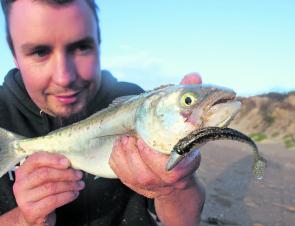
The author with a thumping salmon taken on a soft plastic right close to the beach in a deep gutter.

The blue surf popper is an ultra-reliable method of seeking out those chunky salmon.
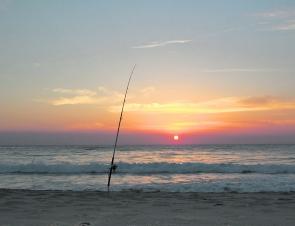
Even when the fishing is quiet the scenery is worth it.
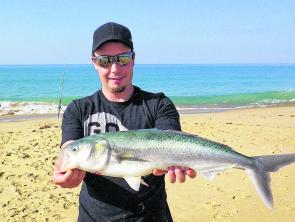
This is a massive salmon – a true sportsfish if there ever was.

Tailor love a lure as well – a red surf popper in this instance.
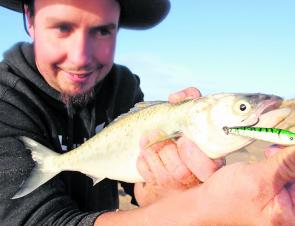
Metal slices and slugs are a great way of covering plenty of water, and catching heaps of fish.

Calm conditions are a great time to use two rods and keep ‘hopping’ along the beach.
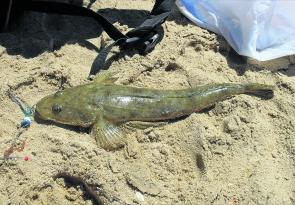
Flathead love a lure and can be a great and tasty by-catch when chasing salmon.

There are a great number of interesting things seen when fishing the ocean beaches – dolphins are there to chase the same fish as anglers are – salmon and tailor.




